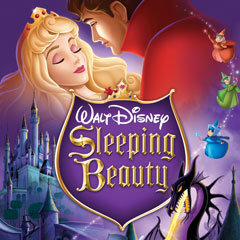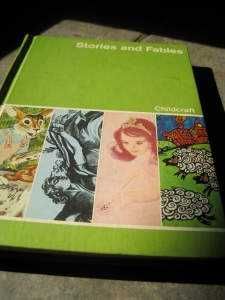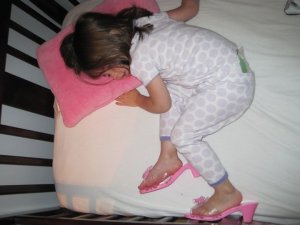We’ve been watching a lot of Disney’s Sleeping Beauty. It’s Kadence’s favorite movie and she loves the music. If you ask her to sing to you, 90% of the time she chooses Once Upon a Dream {the other 10% she sings Deep and Wide}. The movie is beautiful. You know, it took Disney 6 years to make this movie {as Walt tells us in the bonus features of the 50th Anniversary Edition} and 6 million dollars. It was a drastic change for them to move from 35mm film to make it widescreen. Basically the artists had to make their paintings larger and more detailed. They wanted to make it look a lot different from Snow White and Cinderella so they decided to go with a medieval feel – it has much sharper features than the more rounded ones of SW and Cinderella.

The illustrations in Sleeping Beauty had "harsher" and sharper features than the soft rounded look of Snow White {Disney's first sleeping princess}.

Eyvind Earle, the film's color stylist, painted most of the film's sets himself and was given quite a bit of creative freedom, which was unusual.
But as beautiful as the movie is that’s not what even caught my attention. It was the music, which is so classical and different from Snow White {Kadence’s previous Disney princess obsession} that got my attention. In the bonus features, it plays a special that was aired on TV by Disney the day after the movie was released to theaters, “The Peter Tchaikovsky Story.” We normally turn it off at this point but because I was so captivated by the music I wanted to hear more about Tchaikovsky. The feature was definitely Disney dramatic but the hf {hyperfocus} button was pressed nonetheless.
Immediately I wanted the music from the movie. Most of the music in the movie was based off of Peter {Pyotr} Tchaikovsky’s Ballet, The Sleeping Beauty {first performed in 1890}. Tchaikovsky {1840-1893} was a Russian composer that is perhaps best known for his music in ballets, such as Swan Lake, The Sleeping Beauty, and The Nutcracker. I decided I wanted Tchaikovsky’s composition {instead of Disney’s even though Kadence and I thought they did a good job} so I downloaded this CD from iTunes. I also love pure piano music and found out that much of Tchaikovsky’s ballet was transcribed to a piano duet by the Russian pianist, Sergei Rachmaninoff in 1890. And check this out. He was 17. SEVENTEEN! Geesh. It never ceases to amaze me how young geniuses start genius-izing. His piano arrangement of Once Upon a Dream {Opus 66a V. Waltz} is the best and was disgracefully made into my ringtone. You’re welcome Rachmaninoff. After listening to the CSR Symphony Orchestra CD for about a week straight I realized hadn’t relieved my hyperfocus, so I requested Tchaikovsky: His Life and Music by Jeremy Siepmann to be put on the Bookmobile.
I can’t say enough about this book. Written so well I can feel Jeremy Siepmann’s own hf on the subject. He began his hyperfocus of all things Russian as a teen. It started with Russian literature, leading to the Russian language, naturally then to Russian history. It wasn’t until later in life that it led to Russian music and Tchaikovsky in particular. He attributes this late interest to his not becoming an “opera man” until his late fifties and discovering Eugene Onegin and opening the doors to all things Tchaikovsky. The way he writes, shows evidence of his hf which is very refreshing. Many biographies can be boring as authors try not to speculate or draw in between the lines where facts are lacking. The result can be a very boring view of the person at hand. This isn’t the case in this book. He makes it an enjoyable as well as informative read. How he portrays his book is shown in the preface in this quote:
“It {this book} is not an act of revelation, nor does it masquerade as a work of imposing scholarship. It is envisaged as an introduction to both the man and his work, but it is also approached as a story. Its intended readership is emphatically non-specialist.”
That is how I feel about this entire post. I don’t pretend to now be an expert on the subject now and the deeper I get into Tchaikovsky the more I realize how little I know about music. But I think Tchaikovsky was a bunny trail that had to be chased off the path of Sleeping Beauty and so I do that here. To keep this particular post from being long and hard to read, you can continue the topic of Tchaikovsky and my regurgitation of Siepmann’s book in it’s own post cleverly titled, Tchaikovsky.
My research on Tchaikovsky’s ballet naturally led me to the French author Charles Perrault and his book “La Belle au bois dormant” {translated: The Beauty asleep in the wood}, Sleeping Beauty, which is the story that the ballet and Disney’s movie is based off of {published in 1697}. According to Wikipedia, Perrault basically laid the foundation of the genre, the fairy tale. He was pretty much the first to publish folk tales {perhaps you’ve heard of his work, Tales of Mother Goose?} which is where Sleeping Beauty comes from. So of course, I requested The Complete Fairy Tales of Charles Perrault from the Bookmobile as well. This explains a lot of the odd ending in Tchaikovsky’s ballet where they’re celebrating at Aurora’s wedding and characters like Puss and Boots and Little Red Riding Hood are seen dancing. They’re all from Charles Perrault’s Fairy Tales. Can I also just say that there seems to be a pretty strict rule to folklore. I mean, you and I can’t just write down some stuff that we heard from some peeps and call it folk lore. Folklorists take their work seriously and although I don’t fully understand the different levels of folk lore I can trust that those who do have put all of Perrault’s and Grimms fairy tales to the fire and they’ve come through. I’m not saying they’re true stories but that they are truly stories that have been told for centuries. That whole genre of folk lore and fairy tales is a bunny trail for another day {I had no interest in figuring all that out}.
Perrault’s Sleeping Beauty, as to be expected, is quite different from Disney’s version. At first they are small differences- 7 fairies come to bless the child {rather than Disney’s 3}, the fairies don’t raise the child as their own {like in the movie}, the princess isn’t named in the story {she’s named Aurora by her parents and when the fairies are raising her in secret she is called Briar Rose}, and she sleeps for 100 years {versus what seems to be less than a day in the movie}. When she is awaken by the prince, she and “the king’s son” are married, just as in the movie. This is where the movie ends finishing in Disney’s normal happily ever after. However, this is where Perrault’s fairy tale takes a very odd twist {one that I’m quite thankful Disney left out!}. In the story, the prince keeps her hidden at her castle after they’re married for two years, during which they have two children; a girl named Dawn and a boy named Day. It mentions that he hides them because he is afraid of his mother {although she was always good and loved him} because of rumors that she was born of Ogres and was always keeping her desire to eat children at bay. So his father dies and the prince decides to bring his queen and children to join him at his kingdom. I guess he decided to trust his mother because at one point he has to go away and asks his mother to look after his wife and children for him. No longer able to keep her hunger at bay she asks the chef to cook Dawn for her for supper. Scared of her, the chef goes off to do her bidding but can’t do it in the end. So he kills a lamb and covers it in his most delicious sauce and hides the child. His deceit is successful. The next night she wants to eat Day and the chef continues his deceit with a baby goat {I know it’s called a kid but I thought that would be confusing}. He pulls that off as well and so the next night she decides she wants to eat the young Queen {although she’s really not young seeing how she went through a 100 year sleep, but ya know…}. The chef isn’t sure how he’s going to go about deceiving her so he goes to kill sleeping beauty but tells her before hand what’s going on. She says she wants him to do it so she can be with her children {she thought them dead because she couldn’t find them}. That makes him sad so he takes her to the children and decides not to kill her and to deceive the old Queen with a deer. It’s all successful until one day the old queen hears Day crying out in the cellar {and it let’s us know he was crying because he was being punished by his mother for something bad he did} and then the voice of the young queen. So the old queen goes and makes a pit of vipers and dragons and is getting ready to throw the chef and his wife and sleeping beauty and her children into the pit when the king {son of the old queen} happens to show up just in the nick of time. The old queen throws herself in the pit instead so that she doesn’t have to explain herself. …So although this story also ends on a happy note, I’m quite thankful that the whole eating of children is left out of Disney’s version. The bad fairy is bad enough without needing to add on a second villain for Kadence to be scared of. I’m curious, though, how the Sleeping Beauty ballet is done- if it includes this part of the story or not. I do know it was a 4 hour ballet in the beginning so it very well could have. Make it known that if I hear of this ballet being done anywhere somewhat near me, I will do all in my power to get to see it!
So come to find out there’s more than Disney’s version of Sleeping Beauty from Tchaikovsky’s version of Perrault’s version of The Sleeping Beauty. Thrown in the middle there was a version {Dornröschen “Briar Rose,”1812} from another folklorist known as Brother Grimms (which is made up of brothers Jakob and Wilhelm from Germany). So why not throw Household Tales by Brothers Grimm on the BM {no- that’s not bowel movement. I just got tired of typing Bookmobile}? So I did.
But before the book came in I got to go on a short antique shopping trip with some fam. I saw the book section and immediately went searching for some of these original fairy tales. Unfortunately I spent most of my time doing that and didn’t get to see the other wonders the store held. But joyfully I found this book:
This book has many different fables and fairy tales from different authors and includes Brothers Grimm’s version of Sleeping Beauty. Both this book and the one I received from the BM end the story at the wedding, just as Disney does. They have 12 fairy godmothers and a bad fairy versus Disney’s 3 or Perrault’s 7. In this story she’s given a name, Briar Rose, which is where Disney must have pulled Aurora’s second name from. In this version she also actually sleeps out her 100 year sentence and everyone in the kingdom sleeps with her until a prince hears her story and goes looking for her. The briar {which is flowering with roses at this time} opens up for him to enter and thus he finds her and the sleeping kingdom. Can I just take a moment to say that the “illustrations” in the 1974 book are sometimes creepy. Some of them are just illustrated but some of them are photographs of people dressed up or even more disturbing, little dolls dressed up and photographed…

This is from Goldilocks and the Three Bears but it shows the creepy doll photograph "illustrations" I was talking about...
So there we have it, the appeasement of my hyperfocus on Sleeping Beauty. Be sure to check out it’s bunny trail on Tchaikovsky because it really was the highlight of my investigation.
So let’s do a quick little time line including origin so that we can have it laid out neatly {or as my friend Danielle would say, let’s draw it out}.
- 1697 • The Sleeping Beauty by Perrault • France
- 1812 • Briar Rose by Brothers Grimm • Germany
- 1889 • The Sleeping Beauty Ballet by Tchaikovsky • Russia • completed in 1889, first performed in 1890
- 1890 • Transcribed into piano by Rachmaninoff • Russia
- 1959 • Sleeping Beauty by Walt Disney • United States
- 2008 • Disney star Emily Osment disgustingly destroys the song “Once Upon a Dream” in the 50th Anniversary Edition bonus features – sorry, had to throw that in there.
There you have it folks. There was my 2.5 week obsession on Sleeping Beauty. I’d like to end by showing you my very own Sleeping Beauty.






Pingback: Tchaikovsky |
…..wow….. =)
geniusizing…one of my new favorite words
haha…I love it! I think you pretty much hit the nail on the head with this. No you need to do a HF on the movie cars for little man:-)
I’m happy that Mr. Walt left out all the creepy stuff too…then we would have to skip the entire movie.
I think it’s pretty safe to say that Rascal Flatts’ music on Cars will not inspire a HF in me but I can guarantee little man will inspire some sort of HF in me at some point!